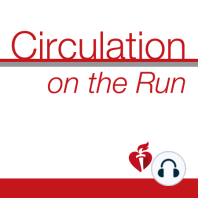25 min listen
Circulation January 8, 2019 Issue
ratings:
Length:
23 minutes
Released:
Jan 7, 2019
Format:
Podcast episode
Description
Dr Carolyn Lam: Welcome to Circulation On The Run, your weekly podcast summary and backstage pass to the journal and it's editors. I'm Dr Caroline Lam, associate editor from the National Heart Center and Duke National University of Singapore. Greg Hundley: And I'm Greg Hundley, Professor at the Pauley Heart Center of Virginia Commonwealth University Health Sciences in Richmond, Virginia. Dr Carolyn Lam: In case you guys missed us last week, this is how our new podcast is gonna work. Greg and I are going to invite you for coffee with us, almost with a journal in hand, and we're gonna chat about the week's issue, highlighting two original papers each, that we thought were awesome. And don't you worry, the feature discussion is still there, authors will join us for a feature discussion right after our coffee. And for this week, the feature paper speaks about the MOMENTUM 3 trial, and talks about the important analysis of stroke outcomes in this trial. But before that, I think Greg, you've got a couple of papers don't you? Greg Hundley: Absolutely Carolyn. So the whole issue, I think we're gonna pick out several stroke papers, really a stroke theme. The first paper is Ankit Maheshwari. He looked at the utility of P-wave morphology on the 12-lead electrocardiogram, to help predict ischemic stroke in patients with atrial fibrillation. Now, how did he do this? Basically, they looked at a large cohort of individuals from the ARIC study, and these were patients that developed atrial fibrillation. And electrocardiograms had been recorded prior to their Afib episode. So, what were they looking for in P-wave morphology? Well, they were looking for changes in Lead three. They were looking for changes in V1. They were also looking for extension of that P-wave. So a prolonged duration. And what they observed, is that that abnormal P-wave, could forecast abnormal atrial remodeling, that might be an indicator of future stroke. Dr Carolyn Lam: Huh, interesting. But is it really reproducible? Did they validate it somehow? Greg Hundley: Yeah, so that's great Carolyn. You know, in papers like this, you like to take a finding in one large cohort, but then you've got to reproduce it. So they went to the MESA Study. Remember now, Mesa are individuals without cardiovascular disease. ARIC are patients with cardiovascular disease. And the finding was reproducible in MESA. Also, what the authors did, is they looked at the relevance of this EKG finding to our existing CHADS-VASc2 scoring system. And what was really smart by these investigators, is that if you added the information from the abnormal P-wave morphology to the CHADS-VASc2 score, you could forecast stroke. Now you say, well CHADS-VASc2 is already pretty reliable, but what about those patients that have a CHADS-VASc score of one right? We're always kind of wondering, do we anticoagulate them? Do we give them aspirin, et cetera. Well if the P-wave morphology was abnormal and they were at higher risk for stroke, that could sway you as a clinician, to go ahead and prescribe anticoagulation for that group of patients. And something very simple, just from the 12-lead EKG before the patients went into atrial fibrillation. You've got a paper that also is sort of focusing on stroke. You want to tell us about that? Dr Carolyn Lam: Yeah, one big data to another big data series. This time, it's Get With The Guidelines Stroke series, and this paper is from Dr Menon from University of Calgary in Canada. Where they described the door to treatment times for endovascular therapy in acute stroke. What is that? Well that's a time interval from when the patient
Released:
Jan 7, 2019
Format:
Podcast episode
Titles in the series (100)
Circulation November 1, 2016 Issue: Dr. Carolyn Lam: Welcome to Circulation On The Run, your weekly podcast summary and backstage pass to the journal and its editors. I'm Dr. Carolyn Lam, Associate Editor from The National Heart Center and Duke National University of Singapore.... by Circulation on the Run
